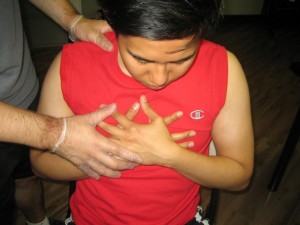Angina is a type of chest pain caused by insufficient supply of oxygen to the heart. When the demand of oxygen of the heart is greater than the supply, the coronary flow of blood is reduced and causes chest pain. Angina is usually a symptom of coronary heart disease.
Causes of angina
- Excessive smoking
- High blood pressure
- High amounts of fats and cholesterol in the blood
- High level of sugar in the blood due to insulin resistance or diabetes
Chest pain behind the sternum, jaw, neck, left shoulder, throat, abdomen, left arm and wrist. - Plaque starts to accumulate in the damaged arteries which is a condition called atherosclerosis. Some plaque is hard and stable and causes the arteries to narrow and stiffen and result to angina. Other plaque is soft and easily breaks and causes blood clots. Blood clots can partially block the coronary arteries and result to angina or heart attack.
Symptoms
- Chest pain behind the sternum, jaw, neck, left shoulder, throat, abdomen, left arm and wrist.
- Severe or stabbing pain with sweating and breathlessness
- Heaviness, pressure, burning, squeezing and choking sensations
- Angina usually last for 1-2 minutes, but if it persists for more than 2 minutes and not relieved by rest, it can be a symptom of a heart attack and requires immediate treatment.
Common risk factor that makes a person susceptible to angina includes being overweight, high blood pressure, not getting plenty of exercise and high levels of cholesterol.
Treatment
- Quit smoking to prevent tightening of the blood vessels that result to high blood pressure. A narrowed blood vessel can block the flow of blood and cause pain in the chest or even death.
- Avoid being stressed. Feeling stressed or upset can cause chest pain. Reduce stress by performing relaxation techniques and exercises such as deep breathing, meditation and yoga.
- Avoid over-exerting the body physically to prevent chest pain. Recognize the symptoms of an oncoming chest pain when performing exercises or physical activities. If chest pain can be felt, stop immediately and take a rest until the chest pain is reduced.
- Eat foods that are good for the heart. Eat a diet rich in fruits and vegetables, high in fiber and low in cholesterol. Eat lean meat and skinless chicken or turkey.
- If overweight, cut down some weight to minimize the workload on the heart and lower the blood pressure. Minimize consumption of alcohol.
- Perform mild to moderate regular exercises such as swimming, brisk walking, dancing, cycling and gardening for at least 30 minutes to lose weight and keep the heart healthy.
- Take the prescribed nitrates to relax and dilate the blood vessels, increase flow of blood to the heart and lessen the workload of the heart. Nitrates are available in two forms – oral and a transdermal patch placed on the skin.
More Information
The details posted on this page on angina is for learning purposes only. To learn to recognize and manage circulatory issues including angina enroll in a first aid course with one of our training providers.

